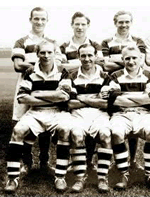News & Updates 2019
10 December - Villa's Piebald Shirts: A Mystery Solved?
On 29 November I wrote about the enigmatic "piebald" shirts worn by Aston Villa around 1886. While Bernard Gallagher was the first to mention these to me in 2009, other Villa experts have also found references to them over time. When I looked into this more closely, the term seems to have been first used in Triumphs of the Football Field Narrated by Archie Hunter" first published in 1890. This volume was reprinted in 1997 so I bought a copy and found the relevant passage on page 154.
"I may also mention that this year (1887) the leopards changed their spots - or rather, the Villa changed their colours, which is, perhaps, simpler. In November we decided to put aside the piebald uniform, which was inartistic and never popular and we donned in its place the light blue and cardinal vertically striped jerseys which afterwards became so well known (emphasis added).
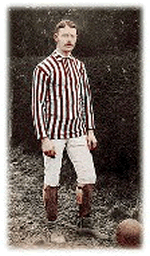 The significance of this passage is that there is no mention of the old shirts being red and white. As I pointed out last month "piebald" means black and white and we know that the team wore stripes in these colours from at least May 1886. Furthermore I have been harbouring doubts that the looms in use at the time were capable of producing fabric with random blotches of colour, an impression confirmed by a recent visit to the Manchester Museum of Science & Industry. Indeed we now know that looms capable of producing fabric with vertical stripes were a recent invention. My conclusion therefore is that the piebald tops were in fact the black and white striped shirts first reported in The Athletic News of May 1886.
The significance of this passage is that there is no mention of the old shirts being red and white. As I pointed out last month "piebald" means black and white and we know that the team wore stripes in these colours from at least May 1886. Furthermore I have been harbouring doubts that the looms in use at the time were capable of producing fabric with random blotches of colour, an impression confirmed by a recent visit to the Manchester Museum of Science & Industry. Indeed we now know that looms capable of producing fabric with vertical stripes were a recent invention. My conclusion therefore is that the piebald tops were in fact the black and white striped shirts first reported in The Athletic News of May 1886.
Hunter's book is, by the way, well worth seeking out. First published in The Birmingham Weekly Mercury in 1890, it is in the form of a series of extended interviews which makes for a discursive style full of the sort of conversational flourishes you might expect from a pair of Victorian chaps relaxing over brandy and cigars. Hence, I suppose, Hunter using the word "piebald" rather than the more pedestrian "black and white stripes."
Archie Hunter was a skillful dribbler and prolific scorer who joined Villa in 1878 by accident. A commanding skipper. He was forced to retire after suffering a heart attack in a  match against Everton in 1890. He died four years later at the age of 35.
match against Everton in 1890. He died four years later at the age of 35.
Eminent Victorians Southern Section: Dulwich Hamlet, Crouch End, Vampires (photograph left - note the fab badge).
Eminent Victorians Midlands Section: Kettering.
6 December - More Victoriana
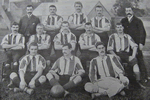 I've added three graphics to the Loughborough section (1892-93, 1894-95). This is the team from 1892-93 wearing very oddly cut striped shirts.
I've added three graphics to the Loughborough section (1892-93, 1894-95). This is the team from 1892-93 wearing very oddly cut striped shirts.
During the 20 years that the original Barnet FC existed (1881-1901) at least four different versions of their violet and black halved shirts were worn simultaneously. I've added a new variant while the others can be seen on the team photograph on the Barnet page.
Eminent Victorians Southern Section: London Caledonians, Chiswick Park, City Ramblers, Clapton, Croydon Common (corrected), Eastbourne.
 The team on the right is Eastbourne FC pictured in February 1892, offering us an object lesson in how deceptive images taken with the orthographic film plates commonly in use at the time can be. To the modern eye, the halved shirts could be made up of red, blue or green panels on the (player's) left combined with black or dark blue on the right. In fact the team played in yellow and dark blue and do so, as Eastbourne Town, to this day.
The team on the right is Eastbourne FC pictured in February 1892, offering us an object lesson in how deceptive images taken with the orthographic film plates commonly in use at the time can be. To the modern eye, the halved shirts could be made up of red, blue or green panels on the (player's) left combined with black or dark blue on the right. In fact the team played in yellow and dark blue and do so, as Eastbourne Town, to this day.
Eminent Victorians Midlands Section: Leicester YMCA, St Neots.
Photographs courtesy of Leicester University and The Straw Plaiters.
4 December - Victorian Miscellany
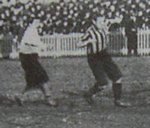 Tony Sealey has confirmed that Tottenham Hotspur adopted navy and white striped change shirts in 1899-1900 three years earlier than previously thought. They are shown here in their amber and chocolate change shirts against Newton Heath in the FA Cup, January 1899.
Tony Sealey has confirmed that Tottenham Hotspur adopted navy and white striped change shirts in 1899-1900 three years earlier than previously thought. They are shown here in their amber and chocolate change shirts against Newton Heath in the FA Cup, January 1899.
We have yet another Aston Villa kit to add to their colourful Victorian collection, (April 1884-1885). Watford Rovers (1894-98 added. I've also updated the early history of the club using 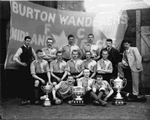 recent research by Brian Webb. Brian has also found evidence that Preston North End adopted striped shirts in 1885-86, neatly filling in a gap in the record. Burton Wanderers (1893-94, 1894-95,1895-96 added). On the
recent research by Brian Webb. Brian has also found evidence that Preston North End adopted striped shirts in 1885-86, neatly filling in a gap in the record. Burton Wanderers (1893-94, 1894-95,1895-96 added). On the  right is the 1895-96 team. Derby County (1891-94 collar corrected). The photograph on the left is of the Rams 1893-94 team in the cardinal red and white shirts worn at the time. Leicester Fosse 1897-98 added.
right is the 1895-96 team. Derby County (1891-94 collar corrected). The photograph on the left is of the Rams 1893-94 team in the cardinal red and white shirts worn at the time. Leicester Fosse 1897-98 added.
(Team photographs courtesy of Leicester University.)
I've made some additions to the Eminent Victorians section drawing on the collection of Victorian team photographs on Brian Webb's The Straw Plaiters site: Apsley, Bedford, Berkhamsted.
Correction
I'm grateful to @BushmanQPR who has confirmed from contemporary sources that the QPR change kit featured in recent post was in fact red and white.
2 December
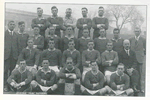 Once again the HFK Elves have proved their worth, in this case by solving the mystery of the Queen's Park Rangers kit shown here and confirming exactly when the club switched from green and white to blue and white hoops into the bargain. Within hours of these questions being posted Richard Essen emailed me with two press cuttings. The first, from the Daily Herald (7 June 1926) reported that the Football League had granted the club permission to change their colours for the following season, 1926-27. The Norwood News (3 September 1926) reported that Rangers wore dark blue jerseys and white knickers at Crystal Palace the previous Saturday. Since there was no colour clash with the home team we can only assume that their new blue and white shirts had not yet arrived. In any event we can now be sure that the mystery
Once again the HFK Elves have proved their worth, in this case by solving the mystery of the Queen's Park Rangers kit shown here and confirming exactly when the club switched from green and white to blue and white hoops into the bargain. Within hours of these questions being posted Richard Essen emailed me with two press cuttings. The first, from the Daily Herald (7 June 1926) reported that the Football League had granted the club permission to change their colours for the following season, 1926-27. The Norwood News (3 September 1926) reported that Rangers wore dark blue jerseys and white knickers at Crystal Palace the previous Saturday. Since there was no colour clash with the home team we can only assume that their new blue and white shirts had not yet arrived. In any event we can now be sure that the mystery  strip was indeed their change kit.
strip was indeed their change kit.
Torquay United (1963-64 added, 1968-69 sock trim added), Manchester United (2019-20 European kit added), Birmingham (1914-15, 1924-25 added - photo right), Bradford City (1983-84 alternative sponsor added).
29 November
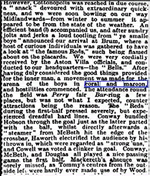 One of the most tantalising and enigmatic kits of the Victorian period was worn by Aston Villa between 1884 and 1886. Discovered by Bernard Gallagher, the shirts were described as being a white and red piebald pattern. The term "piebald" describes the irregular patches of colour against a white background often found in horses but also in dogs, cats and even snakes. (Technically piebald means black on white while skewbald is the correct term for patches in other colours.) Recently Lee Gauntlett came across this cutting from January 1886 which describes Villa playing against Accrington in "coral and maroon" shirts. If, as I believe, Villa still had their red and white tops at this time they would have needed to change to avoid a clash with their visitors' colours so I think this may be the earliest reference to Aston Villa wearing a change kit.
One of the most tantalising and enigmatic kits of the Victorian period was worn by Aston Villa between 1884 and 1886. Discovered by Bernard Gallagher, the shirts were described as being a white and red piebald pattern. The term "piebald" describes the irregular patches of colour against a white background often found in horses but also in dogs, cats and even snakes. (Technically piebald means black on white while skewbald is the correct term for patches in other colours.) Recently Lee Gauntlett came across this cutting from January 1886 which describes Villa playing against Accrington in "coral and maroon" shirts. If, as I believe, Villa still had their red and white tops at this time they would have needed to change to avoid a clash with their visitors' colours so I think this may be the earliest reference to Aston Villa wearing a change kit.
I'm grateful to Michael Gluck for providing details of three missing QPR kits from 1980-82. This was during the period when Adidas were supplying their kit but could not settle on a standard design so every season the placement and width 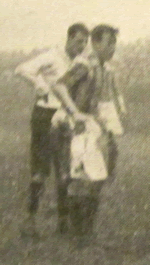 of the hoops changed.
of the hoops changed.
Although we associate QPR with hooped shirts (which were originally green and white) there were two seasons at the beginning of the 20th century when they played in vertical stripes. The photograph on the left shows them playing at Tottenham Hotspur in 1902-03 and if you look closely you can make out their unusual striped collars.
 The photograph on the right was taken in 1925-26 and my first reaction was that the players are wearing their change strip. There is, however, a gap in the record for this season which is very frustrating. The previous season Rangers had worn green and white hoops and in the following season they appeared in blue and white. Can anyone confirm what the team wore in this missing season? Was this in fact their first choice and if so, what colour are the shirts?
The photograph on the right was taken in 1925-26 and my first reaction was that the players are wearing their change strip. There is, however, a gap in the record for this season which is very frustrating. The previous season Rangers had worn green and white hoops and in the following season they appeared in blue and white. Can anyone confirm what the team wore in this missing season? Was this in fact their first choice and if so, what colour are the shirts?
28 November
I apologise for the lack of activity over the last fortnight. A technical issue prevented me from accessing our server and I was unable to post any updates onto the website. This problem has now been resolved and normal service can be resumed.
I've posted the three new Adidas strips launched in the final round of Euro 2020 qualifiers for Scotland, Northern Ireland and Wales. I have to say that the first two are very disappointing but the Welsh outfit is well tidy.
 Our retail partner 3Retro is offering a 20% discount on all purchases on Black Friday (29 November). This will be deducted automatically at the checkout. 3Retro have recently added several new replica shirts to their range that including Arsenal, Aberdeen, Brighton, Burnley and Crystal Palace, which I have now tagged. You can view their entire rnge by clicking on the link on the left or use the deep links throught this website to see specific items.
Our retail partner 3Retro is offering a 20% discount on all purchases on Black Friday (29 November). This will be deducted automatically at the checkout. 3Retro have recently added several new replica shirts to their range that including Arsenal, Aberdeen, Brighton, Burnley and Crystal Palace, which I have now tagged. You can view their entire rnge by clicking on the link on the left or use the deep links throught this website to see specific items.
14 November - Scottish Questions
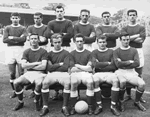 Recently I was sent a couple of photographs that I was was not able to place in the club timelines. The first is of the Aberdeen team in an unrecorded strip sometime in the mid 1960s. I've now established this was worn at Motherwell in March 1964.
Recently I was sent a couple of photographs that I was was not able to place in the club timelines. The first is of the Aberdeen team in an unrecorded strip sometime in the mid 1960s. I've now established this was worn at Motherwell in March 1964.
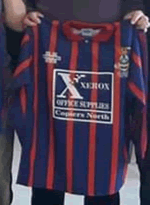 More problematic is this photograph of a Caledonian Thistle shirt recently published on the club's Facebook page. It is almost identical to the 1995-96 shirt supplied by Le Coq Sportif but it is branded with the Matchwinner logo (Matchwinner made their 1994-95 kit) and has a different shirt sponsor. Xerox is listed as a sponsor in 1996 on the club's Wikipedia page but no source is offered. I have not been able to find any evidence to suggest this top was ever worn by the team in competitive matches so would welcome any information that might resolve this mystery.
More problematic is this photograph of a Caledonian Thistle shirt recently published on the club's Facebook page. It is almost identical to the 1995-96 shirt supplied by Le Coq Sportif but it is branded with the Matchwinner logo (Matchwinner made their 1994-95 kit) and has a different shirt sponsor. Xerox is listed as a sponsor in 1996 on the club's Wikipedia page but no source is offered. I have not been able to find any evidence to suggest this top was ever worn by the team in competitive matches so would welcome any information that might resolve this mystery.
5 November 2019-20 Update
Premier League: Norwich City (charity kit added), Brighton & Hove Albion (1st missing trim added), Tottenham Hotspur (3rd colour adjusted), Aston Villa (3rd detailing confirmed).
4 November - Santos Shorts Madness
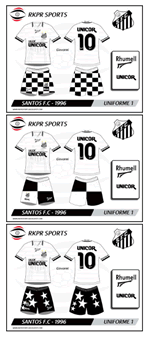 We have become used to teams wearing alternative shorts and socks with their regular tops because of the inconsistently applied regulations on colour clashes but when similar rules were introduced in Brazil in 1996, Santos came up with a novel solution. By tradition, the team play in all-white with a change strip of black and white striped shirts teamed with black shorts. Wearing their alternative black shorts with their iconic white tops, however, would be unthinkable as these are the colours of their arch-rivals, Corinthians. To get round the problem the club commissioned three spectacularly novel sets of shorts all of which appeared in matches.
We have become used to teams wearing alternative shorts and socks with their regular tops because of the inconsistently applied regulations on colour clashes but when similar rules were introduced in Brazil in 1996, Santos came up with a novel solution. By tradition, the team play in all-white with a change strip of black and white striped shirts teamed with black shorts. Wearing their alternative black shorts with their iconic white tops, however, would be unthinkable as these are the colours of their arch-rivals, Corinthians. To get round the problem the club commissioned three spectacularly novel sets of shorts all of which appeared in matches.
Over the following seasons, the team would wear their change strip rather than disfigure their traditional appearance in much the same way that Liverpool refuse to change any elements of their all-red strip.
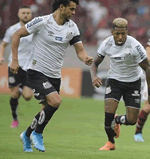 In September of this year, for the first time in 23 years, they took to the field against Flamengo wearing white shirts and black shorts. To avoid the comparision with Corinthians, black socks were worn.
In September of this year, for the first time in 23 years, they took to the field against Flamengo wearing white shirts and black shorts. To avoid the comparision with Corinthians, black socks were worn.
My thanks to regular contributor Gabriel Vogas for this material. You can read more (in Brazilian Portuguese) and see photographs of the 1996 bobby-dazzlers on Gabriel's blog, Uniformes Cultura FC.
30 October - Scottish Club Updates
Rangers (2012-14 1st, 2nd, 3rd detailing tweaked), Brechin City (2013-14 shorts & sock trim corrected), Forfar Athletic (2012-14 shirt trim added), Airdrieonians (August 2013 added), East Fife (2013-14 missing shorts trim added), Dundee (2013-14 cuffs removed), Stranraer (2012-13, 2013-14 trim adjusted), Peterhead (2012-13 missing trim added), Falkirk (2012-13 crest corrected), East Stirlingshire (2012-13 socks corrected), Inverness Caledonian Thistle (2012-13 shirt trim added), Clyde (2012-13 3rd added).
24 October - 2019-20 Update
Championship: Fulham (3rd), Leeds United (3rd, special).
League One: Bolton Wanderers (2nd).
Scottish Premiership: Ross County (special).
21 October - Scottish Club Updates
Rangers (2011-12 1st, 2014-15 3rd detailing added), Aberdeen (2011-12 missing shirt trim added), Dunfermline Athletic (2011-12 Puma logos recoloured), St Johnstone (2011-12 detailing corrected), Motherwell (2011-12 shirt trim corrected, 2014-15 detailing updated), St Mirren (socks corrected), Kilmarnock (2011-12 detailing amended), Falkirk (2014-15 trim amended), Livingston (2014-15 shorts trim adjusted), Queen's Park (2014-15 shorts trim adjusted), Greenock Morton (1989-91, 1993-95 detailing added to shorts).
18 October - More Historical Miscellany
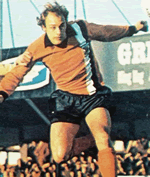 Our old chum Tony Sealey has solved a long-standing riddle concerning Luton Town. When the club adopted orange shirts in 1973, it was unclear whether the trim on the shirt was black or navy. Photographs at the time suggested black but Tony has found a match programme from 1973-74 that confirms once and for all that it was navy blue. The shirts had appeared in February 1973 as a new change kit at Newcastle United and these were indeed trimmed with black and white. The club crest appeared in the pre-season team photograph and in some early games as shown here before it was dropped.
Our old chum Tony Sealey has solved a long-standing riddle concerning Luton Town. When the club adopted orange shirts in 1973, it was unclear whether the trim on the shirt was black or navy. Photographs at the time suggested black but Tony has found a match programme from 1973-74 that confirms once and for all that it was navy blue. The shirts had appeared in February 1973 as a new change kit at Newcastle United and these were indeed trimmed with black and white. The club crest appeared in the pre-season team photograph and in some early games as shown here before it was dropped.
Accrington Stanley (1982-84 added), Barnet (1983-84 sponsorship corrected), Forest Green Rovers (1983-84 added), Macclesfield Town (1982-83, 1983-84 added), Wycombe Wanderers (1982-83 sock trim added).
16 October - Historical Miscellany
 For many years I had thought that when Clapton Orient changed their name to Leyton Orient in 1946 they adopted shirts with blue chevrons, a reference to an older style in the new club colours. This was informed by the photograph on the left taken before the 1947-48 season. Now our old friend Alick Milne has uncovered this report in the Nottingham Evening News (10 April 1945). Clapton Orient have obtained permission from the League to revert to their former colours of white shirts with red V's, which they wore in their Second Division days. For many years they have been wearing red and white hooped shirts. Orient players will appear in the new shirts as soon as they are procurable. This may be before the end of the season. This suggests that the shirts in the photograph, which are showing their age, are from 1945-46 and were retained for training.
For many years I had thought that when Clapton Orient changed their name to Leyton Orient in 1946 they adopted shirts with blue chevrons, a reference to an older style in the new club colours. This was informed by the photograph on the left taken before the 1947-48 season. Now our old friend Alick Milne has uncovered this report in the Nottingham Evening News (10 April 1945). Clapton Orient have obtained permission from the League to revert to their former colours of white shirts with red V's, which they wore in their Second Division days. For many years they have been wearing red and white hooped shirts. Orient players will appear in the new shirts as soon as they are procurable. This may be before the end of the season. This suggests that the shirts in the photograph, which are showing their age, are from 1945-46 and were retained for training.
(Photograph: Leyton Orient Images of Sport NN Kaufmann 2001.)
 Alick has also supplied details of three missing Cove Rangers strips (1975-76, 1985-86, 1987-90).
Alick has also supplied details of three missing Cove Rangers strips (1975-76, 1985-86, 1987-90).
Maidstone United (1962-63 added, 1970-72 crest added, 1985-86 sponsorship confirmed). On the right is the Stones' team from 1922-23.
15 October - 2019-20 Update
International: The strip worn by England last night in Bulgaria has been added.
League One: Coventry City (3rd), Accrington Stanley (3rd).
Historical Miscellany
Tottenham Hotspur (1986-88 2nd colours adjusted), Leicester City (August 1965 added), Motherwell (1983-84 added and all graphics 1978-2013 have been reviewed to add missing detailing and correct main colour).
11 October - 2019-20 Update
Premier League: Wolverhampton Wanderers (European 2nd).
Championship: Birmingham City (3rd), Brentford (special).
League One: Lincoln City (3rd), Bolton Wanderers (1st).
4 October - Scottish Updates
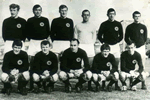 As soon as I published this mystery photograph of the Scotland team, the HFK Elves rushed into action. It turns out to be the team due to play England at Hampden Park in February 1968. (Alan Gilzean, who is in the photograph, was replaced by John Hughes for the match itself.) The photo was taken a few days earlier at a training ground with the players kitted out in plain shirts just for the occasion. They may have been unused tops held over from 1966. My thanks to Alick Milne, John Reid and Greger Lindberg.
As soon as I published this mystery photograph of the Scotland team, the HFK Elves rushed into action. It turns out to be the team due to play England at Hampden Park in February 1968. (Alan Gilzean, who is in the photograph, was replaced by John Hughes for the match itself.) The photo was taken a few days earlier at a training ground with the players kitted out in plain shirts just for the occasion. They may have been unused tops held over from 1966. My thanks to Alick Milne, John Reid and Greger Lindberg.
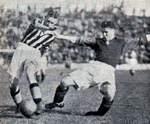
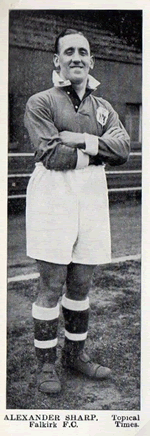 This image from the Aberdeen Press & Journal (22 10 38) is the first photographic corroboration I've seen of Falkirk wearing navy shirts with red sleeves and places this strip a season earlier than previously thought, which means a slight reshuffle of dates. In the process i had another look at this picture of Alexander Sharp who played for the Bairns between 1937 and 1938. As well as showing the unofficial town crest, there is an odd contrast at the collar and the socks are also visibly darker than the shirt. If we assume that our old friend, orthographic film stock was used, then we can resolve the colours as navy with red placquet and socks.
This image from the Aberdeen Press & Journal (22 10 38) is the first photographic corroboration I've seen of Falkirk wearing navy shirts with red sleeves and places this strip a season earlier than previously thought, which means a slight reshuffle of dates. In the process i had another look at this picture of Alexander Sharp who played for the Bairns between 1937 and 1938. As well as showing the unofficial town crest, there is an odd contrast at the collar and the socks are also visibly darker than the shirt. If we assume that our old friend, orthographic film stock was used, then we can resolve the colours as navy with red placquet and socks.
(Photographs: Aberdeen Press & Journal, Football Cartophilic Info Exchange.)
Annan Athletic (circa 1946*, 1952-53), Aberdeen (1936-37, 1937-38, 1938-39 shirts revised), Inverness Thistle (1920-21 added),
 *Date to be confirmed
*Date to be confirmed
I have substantially revised the Brechin City section (1906-1905) with new material supplied by Alick Milne. On the right is a very rare team photograph from 1907-08 that helps resolve one outstanding issue. City's early colours were registered with the Scottish FA as "light blue" but, as we can see from the image, this is misleading. In fact "light blue" was often used in Scotland to distinguish sides that wore mid- or royal blue such as Rangers (and Brechin) from the far greater number of yeams that wore dark, navy blue, which was referred to simply as "blue."
(Photograph: Alex Wood Brechin City: the Early Years.)
1 October - International Update
1938 World Cup: Germany (collar revised).
1954 World Cup: Yugoslavia wore red socks against France.
1978 World Cup: Brazil (socks worn with blue change shirt corrected).
1991 Women's World Cup Group A: Norway (socks corrected and detailing amended). Kits now confirmed for Norway v Denmark match.
1991 Women's World Cup Group B: Brazil wore blue socks against Japan.
1995 Women's World Cup: Brazil (detailing and jacqaurd print corrected).
 This photograph of the Scotland team was sent in by Bill Wilson and presents us with a bit of a problem. As far as I know the team only wore plain navy shirts without contrasting crew necks once in the 1960s, against Wales in 1966. However, the goalkeeper in this line-up is Ronnie Simpson who did not make his debut until the match with England in April 1967. In fact Bill has not been able to identify any match in which this group of players were selected. Help please.
This photograph of the Scotland team was sent in by Bill Wilson and presents us with a bit of a problem. As far as I know the team only wore plain navy shirts without contrasting crew necks once in the 1960s, against Wales in 1966. However, the goalkeeper in this line-up is Ronnie Simpson who did not make his debut until the match with England in April 1967. In fact Bill has not been able to identify any match in which this group of players were selected. Help please.
(Photograph Norway 1991: FIFA.com)
30 September - 2019-20 Update
Premier League: Aston Villa (3rd updated), Wolverhampton Wanderers (special).
Championship: Millwall (3rd).
League One: Bristol Rovers (3rd).
League Two: Exeter City (3rd), Leyton Orient (3rd).
Scottish League One: Stranraer (3rd).
13 September - 2019-20 Update
Championship: Swansea City (3rd).
League One: Shrewsbury Town (3rd).
League Two: Scunthorpe United (3rd).
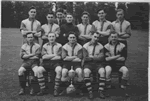 Immediately after the Second World War several clubs were unable to source playing kit in their traditional colours so played in unfamilar strips. A good example is Barnet, pictured here in 1945-46. They reverted to broad amber and black hoops, worn since 1928, the following season. This style was eventually dropped in 1958 and has yet to be revived.
Immediately after the Second World War several clubs were unable to source playing kit in their traditional colours so played in unfamilar strips. A good example is Barnet, pictured here in 1945-46. They reverted to broad amber and black hoops, worn since 1928, the following season. This style was eventually dropped in 1958 and has yet to be revived.
I've reviewed Torquay United's strip 1986-2001 and made several colour corrections and detailing changes.
12 September - Historical Miscellany
Some odds and ends from my Pending Folder.
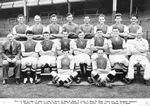 This is Aston Villa in 1956-57, the season they finally dropped the heavy woollen sweaters they had worn since the Victorian era.
This is Aston Villa in 1956-57, the season they finally dropped the heavy woollen sweaters they had worn since the Victorian era.
Arsenal (1962-63 added): Bristol City (1954-55 collar corrected): Everton (1932-32 socks corrected): Gillingham (1969-71 shorts updated).
Brechin City (1989-90, 1997-99 colour corrections): Forfar Athletic (1977-80 detailing corrected): Greenock Morton (1968-69 crest amended).
11 September
 As the first stage in the restructuring of the Welsh pyramid, the Welsh Premier League has been rebranded as the Cymru Premier and the 2019-20 section is now available.
As the first stage in the restructuring of the Welsh pyramid, the Welsh Premier League has been rebranded as the Cymru Premier and the 2019-20 section is now available.
Stoke - The Early Years
Following on from my recent review of Stoke City's kits 1968-83, I've received some fascinating material from Jonathon Russell. His research into newspaper 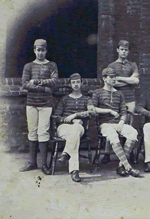 reports between 1868 and 1872 casts doubt on the official version of the club's formation, provides additional information on the connection with Charterhouse School and raises some interesting questions about the link between Stoke Ramblers and Stoke FC which I have now explored on the club page.
reports between 1868 and 1872 casts doubt on the official version of the club's formation, provides additional information on the connection with Charterhouse School and raises some interesting questions about the link between Stoke Ramblers and Stoke FC which I have now explored on the club page.
The most intriguing find is this photograph of members of the 1872 Charterhouse football team wearing crimson and blue jerseys. It is thought that Stoke Ramblers wore the same colours when they were founded in 1868 by Henry Almond, an Old Carthusian who had played for the Charterhouse First XI in his final year at the public school, 1867-68. In the absence of any other evidence, I think this raises the possibility that Almond provided a set of old school tops for the club he founded before he went off to build railways in Costa Rica and Venezuela.
9 September
Edinburgh City have finally launched their new change kit.
6 September - 2019-20 Update
Premier League: Chelsea (3rd), Everton (3rd), Tottenham Hotspur (3rd), Watford (3rd), Wolverhampton Wanderers (Europa League, 3rd).
League One: Peterborough United (3rd).
Scottish League One: East Fife (3rd*).
Historical Miscellany
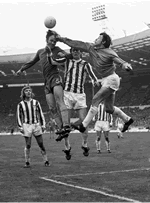 I was prompted by an email from Andy Sharp to add Stoke City's 1972 League Cup final kit to the archive. I normally don't consider the Insert Sponsor Here Cup, as I believe it's now called, sufficiently important to include, but this was Stoke's first (and so far only) major trophy and their shirts had the club crest on for the first time in 15 years so I think that justifies inclusion. I took the opportunity to tweak my graphics for the period 1968-1983.
I was prompted by an email from Andy Sharp to add Stoke City's 1972 League Cup final kit to the archive. I normally don't consider the Insert Sponsor Here Cup, as I believe it's now called, sufficiently important to include, but this was Stoke's first (and so far only) major trophy and their shirts had the club crest on for the first time in 15 years so I think that justifies inclusion. I took the opportunity to tweak my graphics for the period 1968-1983.
Watford (April-May 1963 added): Queens Park Rangers (1974-75 sock trim added): Chelsea (1994-95 European Kit watermark removed).
31 August - Oxford United Update
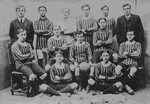 Some time ago I had a discussion with the webmaster at oxfordkits.com about the colours worn by Headington United before they became Oxford United in 1960. I had illustrated these using a dark shade of orange based on the photographic evidence available but now we know about the effect of orthographic film stock I became convinced that this was incorrect. A further puzzle was that I had assumed the lighter shirts worn in the 50s were gold but when I managed to find some match programmes and club handbooks they consistently described the team's colours as orange and blue. I've now finished a complete revision of the Oxford United page and, using oxfordkits.com as a reference, rendererd the shades of gold and yellow worn by the modern club with greater accuracy. Incidentally, it has come to light that Headington did not add "United" to their name until 1911 after they merged with another local club. The photograph is of the original Headington AFC wearing unusual striped jerseys in 1910.
Some time ago I had a discussion with the webmaster at oxfordkits.com about the colours worn by Headington United before they became Oxford United in 1960. I had illustrated these using a dark shade of orange based on the photographic evidence available but now we know about the effect of orthographic film stock I became convinced that this was incorrect. A further puzzle was that I had assumed the lighter shirts worn in the 50s were gold but when I managed to find some match programmes and club handbooks they consistently described the team's colours as orange and blue. I've now finished a complete revision of the Oxford United page and, using oxfordkits.com as a reference, rendererd the shades of gold and yellow worn by the modern club with greater accuracy. Incidentally, it has come to light that Headington did not add "United" to their name until 1911 after they merged with another local club. The photograph is of the original Headington AFC wearing unusual striped jerseys in 1910.
(Photograph: Headington.org.uk)
29 August - Boston United Update
 I'm grateful to Alick Milne for some new and very detailed research on Boston United that has allowed me to revise the records for the club from their formation in 1933 up until 1970. The photograph here is of the 1958-59 team wearing striped shirts for the first time. An intriguing detail is the crest which I think may depict St Botolph's Church, a prominent local landmark.
I'm grateful to Alick Milne for some new and very detailed research on Boston United that has allowed me to revise the records for the club from their formation in 1933 up until 1970. The photograph here is of the 1958-59 team wearing striped shirts for the first time. An intriguing detail is the crest which I think may depict St Botolph's Church, a prominent local landmark.
(Photograph: Ken Fox, BUFC Website.)
28 August
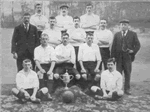 The news about Bury is desperately sad and I extend my heartfelt sympathy to the supporters who have been let down so badly. The club is at the heart of the town and while it may have been overshadowed by the bigger clubs in the Greater Manchester area, we should remember that they were once one of the aristocrats of the game and won the FA Cup twice in 1900 (pictured) and 1903. While it is clear that gross financial mismanagement over many years has brought the club to disaster the EFL must accept their share of responsibility. The Owners' and Directors' Test (commonly known as the Fit and Proper Person Test) and the current Financial Fair Play rules are simply not fit for purpose and must be overhauled. Bury are the latest in a lengthening list of clubs that includes Portsmouth, Blackburn Rovers, Blackpool, Coventry City, Notts County and Bolton Wanderers which have been brought to their knees by predatory or incompetent owners. Proposals to tighten up the rules were put forward at the July 2018 meeting of the EFL put since then nothing has happened and it is only a matter of time before history repeats itself.
The news about Bury is desperately sad and I extend my heartfelt sympathy to the supporters who have been let down so badly. The club is at the heart of the town and while it may have been overshadowed by the bigger clubs in the Greater Manchester area, we should remember that they were once one of the aristocrats of the game and won the FA Cup twice in 1900 (pictured) and 1903. While it is clear that gross financial mismanagement over many years has brought the club to disaster the EFL must accept their share of responsibility. The Owners' and Directors' Test (commonly known as the Fit and Proper Person Test) and the current Financial Fair Play rules are simply not fit for purpose and must be overhauled. Bury are the latest in a lengthening list of clubs that includes Portsmouth, Blackburn Rovers, Blackpool, Coventry City, Notts County and Bolton Wanderers which have been brought to their knees by predatory or incompetent owners. Proposals to tighten up the rules were put forward at the July 2018 meeting of the EFL put since then nothing has happened and it is only a matter of time before history repeats itself.
27 August
Simon Ståålrecently discovered a fascinating article concerning Queen's Park Rangers in 1950. Although rationing was beginning to be relaxed some items remained in short supply and this included sportswear. It was not unusual for teams to appeal to their supporters for ration coupons that could be used to replace worn out kit. Socks were a particular problem as they wore out quickly so Rangers offered to supply needles and wool to anyone (and let's be frank here, we're talking about the ladies) prepared to darn the player's socks. Hearing of this, 80-year-old Miss Gertrude Parker set about knitting with a will and in due course, after going through 12ibs (5.44kg) of wool, she presented 24 pairs of pristine blue and white socks to the club. You can read the full article by Steve Russell on the Independents R's website.
Salford City Update
Over the summer the elves have been busy digging out information on Salford City's early strips and I've been able to add a number of previously unrecorded strips from 1980-81 through to 2006-07. Unfortunately, with the exception of the 2006-07 kit, the information has been gleaned from North-West Counties and other non-league handbooks so the details are very basic but it is a start. Sadly, absolutely nothing has come to light about the first forty years of the club's history when they played in minor local leagues.
20 August - 2019-20 Update
Premier League: Burnley (3rd), Manchester United (3rd).
Championship: Blackburn Rovers (3rd).
League One: Bolton Wanderers (temporary 2nd).
League Two: Swindon Town (3rd).
15 August - 2019-20 Update
Championship: Hull City (3rd).
League One: Bristol Rovers (2nd).
League Two: Newport County (4th).
Scottish Premiership: Hamilton Academical (1st, 2nd).
Scottish Championship: Queen of the South (Special).
Scottish League One: Peterhead (1st, 2nd).
Scottish League Two: Edinburgh City (1st, 3rd), Elgin City (1st*, 2nd*), Queen's Park (1st*, 2nd*), Stenhousemuir (1st, 2nd), Stirling Albion (1st*, 2nd).
13 August - 2019-20 Update
Premier League: Everton (last season's 3rd kit worn at Crystal Palace added).
Championship: Huddersfield Town (Paddy Power hoax shirt added).
League Two: Port Vale (1st socks confirmed).
Scottish Premiership: Hibernian (3rd), Celtic (3rd).
Scottish Championship: Queen of the South (2nd shorts/socks confirmed), Alloa Athletic (1st, 2nd), Dundee United (2nd).
Scottish League One: Forfar Athletic (1st,* 2nd), Clyde (1st, 2nd, 3rd), East Fife (1st, 2nd), Dumbarton (2nd shorts/socks confirmed).
Scottish League Two: Albion Rovers (3rd), Annan Athletic (1st*, 2nd*).
Former Members: East Stirlingshire.
9 August - 2019-20 Update
Premier League: Crystal Palace (3rd), Manchester City (Special Edition).
Championship: Blackburn Rovers (1st colour corrected).
League One: Lincoln City (2nd socks confirmed).
League Two: Bradford City (3rd), Morecambe (1st, 2nd socks confirmed), Newport County (3rd), Stevenage (1st, 2nd shorts/socks confirmed)..
Former Members: Aldershot Town*, Boston United*, Chesterfield, Kidderminster Harriers, Yeovil Town (shorts/socks confirmed).
*Unchanged.
8 August - 2019-20 Update
Premier League: Newcastle United (3rd), Watford (2nd), Norwich City (3rd).
Championship: Leeds United (2nd), Huddersfield Town (3rd).
League One: Peterborough United (2nd), Bolton Wanderers (temporary kit).
League Two: Mansfield Town (3rd), Forest Green Rovers (3rd), Exeter City (1st, 2nd).
Former Members: Notts County.
5 August - 2019-2020 Update
Premier League: Newcastle United (2nd), Sheffield United (3rd), AFC Bournemouth (2nd).
Championship: Reading (1st, 2nd), Charlton Athletic (2nd), West Bromwich Albion (3rd), Barnsley (3rd), Blackburn Rovers (2nd shorts corrected).
League One: Bristol Rovers (1st), Southend United (2nd), Rochdale (1st, 2nd, 3rd), Gillingham (1st, 2nd shorts trim added).
League Two: Walsall (3rd), Plymouth Argyle (3rd), Macclesfield Town (1st, 2nd), Oldham Athletic (1st, 2nd).
2 August - 2019-20 Update
Championship: Millwall (2nd), Barnsley (2nd).
League One: Oxford United (2nd), Portsmouth (2nd, 3rd).
League Two: Salford City (1st, 2nd).
1 August
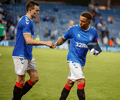 The High Court in London has ordered Rangers to pay £450,000 to Sports Direct and banned the club from wearing or selling Hummel merchandise in 2020-21. This is the latest development in a legal battle that began after Rangers confirmed a three-year deal with the Danish sportwear supplier worth £10m. In July 2018 Sports Direct were granted an interim injunction preventing the club from selling replica Hummel strips. The injunction was lifted after two months but nowJudge Lionel Persey QC has ruled that Rangers were in breach of their contract with Sports Direct by entering into an agreement with Hummel without offering Sports Direct the opportunity to exercise its right to match part or all of the rival offer.
The High Court in London has ordered Rangers to pay £450,000 to Sports Direct and banned the club from wearing or selling Hummel merchandise in 2020-21. This is the latest development in a legal battle that began after Rangers confirmed a three-year deal with the Danish sportwear supplier worth £10m. In July 2018 Sports Direct were granted an interim injunction preventing the club from selling replica Hummel strips. The injunction was lifted after two months but nowJudge Lionel Persey QC has ruled that Rangers were in breach of their contract with Sports Direct by entering into an agreement with Hummel without offering Sports Direct the opportunity to exercise its right to match part or all of the rival offer.
More details in The Scottish Sun. Photograph: Willie Vass - The Sun
2019-20 Update
Premier League: Liverpool (3rd), Norwich City (2nd).
Championship: Blackburn Rovers (2nd).
League One: Tranmere Rovers (2nd), Shrewsbury Town (1st, 2nd), Gillingham (3rd), Blackpool (1st, 2nd).
30 July - 2019-20 Update
Premier League: West Ham United (3rd), Chelsea (2nd), Crystal Palace (2nd), Burnley (2nd).
Championship: Birmingham City (2nd), Huddersfield Town (1st, 2nd)..
League One: Peterborough United (1st).
League Two: Newport County (1st, 2nd).
Scottish League One: Stranraer (1st, 2nd).
26 July - 2019-20 Update
Premier League: Watford (1st).
Championship: Charlton Athletic (1st), Brentford (2nd), Nottingham Forest (2nd), Sheffield Wednesday (1st, 2nd) Nottingham Forest (Special Edition).
League Two: Scunthorpe United (1st, 2nd).
Former Members: Barnet.
Scottish Championship: Inverness Caledonian Thistle (3rd).
22 July - 2019-20 Update
Premier League: Tottenham Hotspur (1st, Eur, 2nd).
Championship: Charlton Athletic (3rd).
League One: Doncaster Rovers (2nd).
League Two: Cheltenham Town (1st*, 2nd), Colchester United (1st, 2nd, 3rd*).
Former Members: Hartlepool United.
Scottish Championship: Queen of the South (1st, 2nd), Inverness Caledonian Thistle (1st, 2nd*).
Scottish League Two: Brechin City (1st, 2nd).
*Unchanged.
21 July - 2019-20 Updates
Scottish Premiership: Kilmarnock (1st, 2nd, 3rd), St Mirren (1st, 2nd), Livingston (1st, 2nd), Heart of Midlothian (3rd).
Scottish Championship: Dundee United (1st), Arbroath (1st, 2nd), Dundee (2nd), Dunfermline Athletic (1st, 2nd).
Scottish League One: Dumbarton (1st, 2nd), Airdrieonians (1st, 2nd, 3rd).
Scottish League Two: Cowdenbeath (1st, 2nd), Albion Rovers (1st, 2nd), Cove Rangers (1st, 2nd).
Former Members: Berwick Rangers.
17 July - 2019-2020 Update
Premier League: Manchester United (2nd).
Championship: Barnsley (1st), Leeds United (1st), West Bromwich Albion (2nd).
League One: Coventry City (1st, 2nd), Sunderland (2nd), Lincoln City (2nd).
League Two: Crawley Town (1st, 2nd), Bradford City (2nd).
Leeds United Centenary
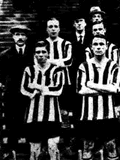 I was looking into Leeds United's inaugural season, 1919-20, and found clear, photographic evidence on the excellent Leeds United FC History website that the team wore black and white stripes and black knickers in the Midlands League
I was looking into Leeds United's inaugural season, 1919-20, and found clear, photographic evidence on the excellent Leeds United FC History website that the team wore black and white stripes and black knickers in the Midlands League 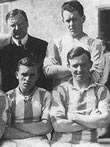 and in friendly matches during that first season. The following season they were admitted to the Football League. By this stage their chairman was J Hilton-Crowther who took over the fledgling club after his proposal to merge it with Huddersfield Town (where he was previously chairman) had been thwarted. It was he who insisted that Leeds adopt blue and white, the colours of his former club.
and in friendly matches during that first season. The following season they were admitted to the Football League. By this stage their chairman was J Hilton-Crowther who took over the fledgling club after his proposal to merge it with Huddersfield Town (where he was previously chairman) had been thwarted. It was he who insisted that Leeds adopt blue and white, the colours of his former club.
(Photographs Neil Roche courtesy of Leeds United FC History.)
16 July - 2019-20 Updates
Premier League: Arsenal (2nd, 3rd), AFC Bournemouth (3rd), Aston Villa (1st, 2nd, 3rd).
Championship: Hull City (2nd), Cardiff City (2nd).
League One: Wycombe Wanderers (1st*, 2nd), Gillingham (1st, 2nd).
League Two: Forest Green Rovers (1st, 2nd), Swindon Town (2nd).
Former members: Yeovil Town, Stockport County, Torquay United.
12 July - 2019-2020 Update
Premier League: Wolverhampton Wanderers (1st).
Championship: Blackburn Rovers (1st) Millwall (1st), Wigan Athletic (1st, 2nd), Derby County (2nd).
League One: Portsmouth (3rd).
League Two: Grimsby Town (1st, 2nd, 3rd).
10 July - 2019-20 Updates
Premier League: Sheffield United (1st, 2nd).
Championship: Nottingham Forest (1st), Bristol City (2nd), Swansea City (1st, 2nd).
League One: Burton Albion (1st), AFC Wimbledon (3rd).
League Two: Leyton Orient (1st, 2nd), Salford City (3rd), Stevenage (1st, 2nd).
Former members: York City.
8 July
 Our congratulations go to the United States Women's team who yesterday won their fourth Women's World Cup in style. Among many memorable moments of the tournament my personal favourite was the proud, joyful pose struck by the American's co-caption, Megan Rapinoe after she scored her six goals, an achievement that won her the Golden Boot award as well as the Golden Ball. The outspoken Rapinoe is an advocate for numerous LGBTQ+ organisations as well as gender equality and most recently has criticised FIFA for disrespecting the women's game by scheduling the finals of the men's North and South American confederation competitions on the same day as the Women's World Cup final.
Our congratulations go to the United States Women's team who yesterday won their fourth Women's World Cup in style. Among many memorable moments of the tournament my personal favourite was the proud, joyful pose struck by the American's co-caption, Megan Rapinoe after she scored her six goals, an achievement that won her the Golden Boot award as well as the Golden Ball. The outspoken Rapinoe is an advocate for numerous LGBTQ+ organisations as well as gender equality and most recently has criticised FIFA for disrespecting the women's game by scheduling the finals of the men's North and South American confederation competitions on the same day as the Women's World Cup final.
(Photograph Benoît Tessier/Reuters)
2019-20 Updates
Premier League: Norwich City (1st), Arsenal (1st), Everton (1st).
6 July - 2019-20 Updates
Premier League: Burnley (1st).
Championship: Fulham (1st, 2nd, special edition), Cardiff City (1st, 3rd), Queens Park Rangers (1st, 2nd, 3rd) Bristol City (1st).
League One: Rotherham United (3rd), Milton Keynes Dons (1st, 2nd, 3rd), Lincoln City (1st).
League Two: Northampton Town (2nd), Crewe Alexandra (1st, 2nd), Morecambe (1st, 2nd), Mansfield Town (2nd*).
2 July
The FIFA Women's World Cup section has been updated.
2019-20 Update
Premier League: Manchester City (1st, 2nd, 3rd).
Championship: Preston North End (last season's 2nd kit now to be retained).
Scottish Premiership: Motherwell (1st, 2nd), Hibernian (1st, 2nd), Celtic (2nd), Heart of Midlothian (2nd).
Scottish League One: Raith Rovers (1st).
28 June - 2019-20 Updates
 While working on the latest Scottish club kits I was disturbed to read that Partick Thistle's decision to include the LGBTQ+ Pride colours on their new change shirt has attracted negative comment on social media. Thistle have always been an inclusive club, an important position to take in a city where religious bigotry has disfigured the game for too long. It is therefore perfectly logical for the club to make a positive statement about the LGBTQ+ community. Homophobia is pervasive in football. In 130 years there has been only one openly gay professional footballer in Scotland yet, according to a 2017 report by the Office of National Statistics, 6.8% of the UK population identify as LGBTQ+. Thistle's stance may be just one tiny step in tackling this issue but here at HFK Towers, we are fully behind them. Well played Thistle.
While working on the latest Scottish club kits I was disturbed to read that Partick Thistle's decision to include the LGBTQ+ Pride colours on their new change shirt has attracted negative comment on social media. Thistle have always been an inclusive club, an important position to take in a city where religious bigotry has disfigured the game for too long. It is therefore perfectly logical for the club to make a positive statement about the LGBTQ+ community. Homophobia is pervasive in football. In 130 years there has been only one openly gay professional footballer in Scotland yet, according to a 2017 report by the Office of National Statistics, 6.8% of the UK population identify as LGBTQ+. Thistle's stance may be just one tiny step in tackling this issue but here at HFK Towers, we are fully behind them. Well played Thistle.
Scottish Premiership: Aberdeen (2nd), Saint Johnstone (1st, 2nd).
Scottish Championship: Dundee (1st), Partick Thistle (1st, 2nd), Greenock Morton (1st*, 2nd).
Scottish League One: Falkirk (1st, 2nd).
27 June - 2019-20 Updates
League Two: Bradford City (1st), Carlisle United (1st, 2nd).
Championship: Middlesbrough (2nd).
26 June
The FIFA Women's World Cup section has been updated.
2019-20 Update
Premier League: Newcastle United (1st).
Championship: Derby County (1st), Brentford (1st), Hull City (1st), Preston North End 3rd*).
League One: Tranmere Rovers (1st), Doncaster Rovers (1st), Accrington Stanley (1st*, 2nd*).
League Two: Cambridge United (1st, 2nd), Mansfield Town (1st).
Former members: Dagenham & Redbridge.
18 June
The FIFA Women's World Cup section has been updated.
2019-2020 Updates
Premier League: Brighton & Hove Albion (1st, 2nd), Liverpool (2nd).
League One: Rotherham United (2nd), Fleetwood Town (1st*, 2nd*).
League Two: Plymouth Argyle (2nd).
Scottish Premiership: Ross County (1st, 2nd), Heart of Midlothian (1st).
14 June
The FIFA Women's World Cup section has been updated.
The variant kits worn by Northern Ireland in their recent Euro Qualifiers have been added.
2019-2020 Updates
Premier League: West Ham United (1st, 2nd).
Championship: Preston North End (1st, 2nd), Birmingham City (1st).
League One: Oxford United (1st).
League Two: Swindon Town (1st), Walsall (1st, 2nd).
11 June
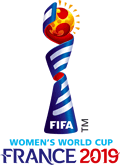 I have begun updating the FIFA Women's World Cup section.
I have begun updating the FIFA Women's World Cup section.
The UEFA Nations League Finals section is now complete.
7 June - 2019-20 Updates
Premier League: Leicester City (2nd, 3rd), Brighton & Hove Albion (3rd).
Championship: Middlesbrough (1st).
League One: Ipswich Town (1st, 2nd, 3rd*), AFC Wimbledon (1st*, 2nd*), Rotherham United (1st).
6 June
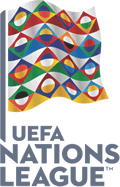 I've added the first semi-final of the European Nations Cup to the site.
I've added the first semi-final of the European Nations Cup to the site.
2019-20 Updates
Premier League: Manchester United (1st), Southampton (1st, 2nd, 3rd), AFC Bournemouth (1st).
League One: Burton Albion (2nd*), Sunderland (1st).
Former members: Wrexham.
*Unchanged.
5 June
Overnight I received some new material on Salford City that allows me to add details of a merger and change of name in 1980, some additional crests, three new kit graphics (1984-85, 1995-96, 1999-2000) and a team photograph from 1984-85. My thanks go to Frank McCauley and Ralph Pomeroy for this.
The 2019 Champions League final has been added.
2019-20 Updates
Premier League: Leicester City (1st), Crystal Palace (1st).
Championship: Luton Town (1st, 2nd, 3rd), Stoke City (1st, 2nd), West Bromwich Albion).
League Two: Plymouth Argyle (1st).
4 June
 I have now set up the new Salford City section but constructing a complete kit history is proving very difficult indeed. The club spent the first 23 years of their existence in local Manchester Leagues and a fire in 2009 destroyed most of their records. I would welcome any help that the HFK Elves can provide here. You know who you are.
I have now set up the new Salford City section but constructing a complete kit history is proving very difficult indeed. The club spent the first 23 years of their existence in local Manchester Leagues and a fire in 2009 destroyed most of their records. I would welcome any help that the HFK Elves can provide here. You know who you are.
(Photograph courtesy of the Manchester Evening News.)
3 June
 The 2019-20 English and Scottish Season Galleries are now open!
The 2019-20 English and Scottish Season Galleries are now open!
(Photograph courtesy of Flashbak.)
I am extremely gratful to Gabriel Vogas from Brazil who has been beavering away filling in the gaps in our records of the 1991 and 1995 Women's World Cups. The final missing piece of the jigsaw was found this morning after Gabriel contacted Fernando Pires, who coached the 1991 Brazil team and was able to confirm the colours worn in the Brazil v Sweden match.
23 May
 Warm congratulations from all at HFK Towers go to Cove Rangers who now feature in our Scottish Clubs section. Of course, to achieve this signal honour, the team had to go to all the trouble of winning the promotion play-off with Berwick Rangers to earn a place in Scottish League Two.
Warm congratulations from all at HFK Towers go to Cove Rangers who now feature in our Scottish Clubs section. Of course, to achieve this signal honour, the team had to go to all the trouble of winning the promotion play-off with Berwick Rangers to earn a place in Scottish League Two.
There are, as you might expect, a lot of gaps in the record for the Toonsers and any help to fill these in will be much appreciated. Salford City will be added shortly to the English section.
21 May
I've added the 2019 FA Cup final kit graphics.
2019-20 Scottish Update: Ayr United, Rangers, Celtic, Aberdeen added.
16 May
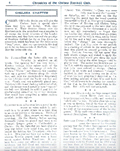 The HFK Elves have been busy delving into the mystery of the 1915 FA Cup semi-final featured a couple of days ago. Steve Flanagan, our Everton expert, has found match reports in the Liverpool Evening Express and the local Football Pink which both state that Everton wore black and white stripes while Chelsea played in white. Steve suggests
The HFK Elves have been busy delving into the mystery of the 1915 FA Cup semi-final featured a couple of days ago. Steve Flanagan, our Everton expert, has found match reports in the Liverpool Evening Express and the local Football Pink which both state that Everton wore black and white stripes while Chelsea played in white. Steve suggests 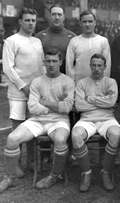 Everton's change shirts may have been in the laundry with their blue tops and the colours had run prompting the editor of the Chelsea Chronicle to describe them as "a dirty looking mixture of dark blue and light blue." Judging by this photo of the Chelsea side in what look like distinctly dingy jerseys, he was being less than even-handed.
Everton's change shirts may have been in the laundry with their blue tops and the colours had run prompting the editor of the Chelsea Chronicle to describe them as "a dirty looking mixture of dark blue and light blue." Judging by this photo of the Chelsea side in what look like distinctly dingy jerseys, he was being less than even-handed.
Incidentally, Chelsea also changed into blue stockings for this match and these were also worn in the final.
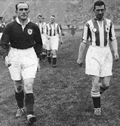 Barry Weekley was in touch a little while ago questioning whether my graphic for Arsenal's kit in the 1930 FA Cup final was correct. He argued that the team wore red socks rather than black. His point is well illustrated by this photograph of the captains leading the teams out at Wembley. This prompted me to examine the photographic record and I found that Arsenal switched from black to red socks at the beginning of the 1929-30 season and retained these until March 1933 when the famous red shirts with white sleeves were introduced. This set, of course, featured navy and white socks.
Barry Weekley was in touch a little while ago questioning whether my graphic for Arsenal's kit in the 1930 FA Cup final was correct. He argued that the team wore red socks rather than black. His point is well illustrated by this photograph of the captains leading the teams out at Wembley. This prompted me to examine the photographic record and I found that Arsenal switched from black to red socks at the beginning of the 1929-30 season and retained these until March 1933 when the famous red shirts with white sleeves were introduced. This set, of course, featured navy and white socks.
Burnley (1996-98 amended).
14 May - Historical Material
 This grainy image from the Sunday Pictorial (March 29 1915) was submitted a while ago by Tony Sealey and Nik Yeomans. It's a rare photograph of the FA Cup semi-final between Chelsea and Everton and it raises some awkward questions. As it's the FA Cup and colours clashed, both teams were expected to change but according to contemporary programme notes (April 2 1915), Everton wanted to apply the rules of the Football League which would have allowed them, as the senior side, to play in blue. The FA, however, ordered that both teams change and they did, but not into their regular alternative strips (which would have been perfectly adequate). Chelsea wore white while Everton turned out in "a dirty looking mixture of dark blue and light blue."
This grainy image from the Sunday Pictorial (March 29 1915) was submitted a while ago by Tony Sealey and Nik Yeomans. It's a rare photograph of the FA Cup semi-final between Chelsea and Everton and it raises some awkward questions. As it's the FA Cup and colours clashed, both teams were expected to change but according to contemporary programme notes (April 2 1915), Everton wanted to apply the rules of the Football League which would have allowed them, as the senior side, to play in blue. The FA, however, ordered that both teams change and they did, but not into their regular alternative strips (which would have been perfectly adequate). Chelsea wore white while Everton turned out in "a dirty looking mixture of dark blue and light blue."
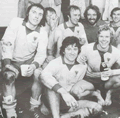 Tony Sealey has been kind enough to send me a detailed account of the strips worn by the original Wimbledon club between 1974 and 1977, a period that brought three Southern League titles on the trot, an epic FA Cup run and election to the Football League. The club switched from all-blue to yellow and blue in April 1974 (see right). The following year, a local sports shop owner donated two sets of new kit for their FA Cup matches against Burnley and Leeds United which were adopted as lucky strips for league matches. An all-white outfit appeared in an FA Cup match in December 1976 and was then worn in their final Southern League fixtures.
Tony Sealey has been kind enough to send me a detailed account of the strips worn by the original Wimbledon club between 1974 and 1977, a period that brought three Southern League titles on the trot, an epic FA Cup run and election to the Football League. The club switched from all-blue to yellow and blue in April 1974 (see right). The following year, a local sports shop owner donated two sets of new kit for their FA Cup matches against Burnley and Leeds United which were adopted as lucky strips for league matches. An all-white outfit appeared in an FA Cup match in December 1976 and was then worn in their final Southern League fixtures.
9 May - 2019-20 Club Updates
Stoke City, Chelsea, West Bromwich Albion, AFC Bournemouth, Luton Town.
7 May - 2019 Women's World Cup Update
2019 Women's World Cup Update: I've added the new Cameroon kits and tweaked detailing on the kits of Chile, China, Jamaica, Nigeria and the USA. There is till no news on Argentina or Japan.
2019-20 Club Updates
As the first 2019-20 kits are now being released I shall start adding these to the archive. As usual the Season Galleries for 2019-20 will be opened once the last of the promotion and relegation issues have been settled.
First off the blocks are Liverpool, and Plymouth Argyle.
30 April
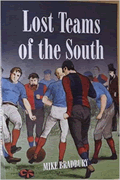 Today I am going to review Mike Bradbury's recently published Lost Teams of the South, the third in a trilogy that has previously covered the Midlands and North of England. In my view, this is the best of the bunch, charting as it does how the game evolved among the privileged aristocrats with time and money on their hands.
Today I am going to review Mike Bradbury's recently published Lost Teams of the South, the third in a trilogy that has previously covered the Midlands and North of England. In my view, this is the best of the bunch, charting as it does how the game evolved among the privileged aristocrats with time and money on their hands.
In a well written (if poorly proof-read) introduction, Bradbury explores the personalities who brought the game in its various forms from their public schools into the public arena. We learn how fluidly the game was organised with teams appearing and disappearing all the time, often leading a semi-nomadic existence and playing under different codes (frequently in the same match). Gentlemen, unconcerned by the need to earn a living, might turn out for several sides in the course of a week and more than one team scratched from the FA Cup because their best players had been picked for the opposition.
The bulk of the book offers detailed accounts of more than fifty defunct teams, some famous such as The Wanderers, Barnes and The Casuals and some gloriously obscure like No Names Kilburn, Gitanos and Minerva. Even when very little is recorded, Bradbury's impeccable and dogged research uncovers lost details of each club's career, where they played, press reports and in most cases, who their most prominent players were.
Highly recommended by HFK, Lost Teams of the South is available direct from the author for £16.99 + £3 P&P at mbradbury42@yahoo.co.uk.
Using this book as a reference I have added fourteen new images to the Eminent Victorians section and updated a number of existing entries.
29 April
 Leigh Roose of the Welsh Football Data Archive has turned up some more colours in the bewildering sequence worn by the Wales team in the Victorian period. In April 1889 they wore light blue against Scotland and green/white against Ireland. He also confirms that the team wore green and white halves in 1900 against England. The photograph is from March 1887 when the team wore red although one player
Leigh Roose of the Welsh Football Data Archive has turned up some more colours in the bewildering sequence worn by the Wales team in the Victorian period. In April 1889 they wore light blue against Scotland and green/white against Ireland. He also confirms that the team wore green and white halves in 1900 against England. The photograph is from March 1887 when the team wore red although one player 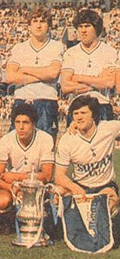 seems to be in the older cardinal and white top worn in 1885.
seems to be in the older cardinal and white top worn in 1885.
Middlesbough (1996-97 socks corrected).
This oddity, found by Tony Sealey, shows Tottenham Hotspur in unfamilar sponsored shirts which were worn on a brief tour of Turkey in June 1981 which was sponsored by Sultan Hali, who manufacture carpets. Tony has also contributed an alternative change strip worn 1930-34. I have revised the sequence of strips worn 1883-1885 in line with the findings published in The Spurs Shirt (Shakeshaft, Burney, Evans 2018) which Tony helped research. Other additions include two special kits for floodlit matches, a white one from 1955 and a gold version from 1958.
25 April
Elgin City (1992-93 added), St Johnstone (1979-80 corrected), Caledonian (1992-93, 1993-94 added).
24 April - Historical Updates
 In September 1983 Rangers travelled to Malta to play Valletta in the European Cup Winners' Cup and wore these shirts which lacked the pinstripes worn in domestic competition at the time. Lindsay Stewart has suggested they may have been made of Aertex cotton which will not take printing.
In September 1983 Rangers travelled to Malta to play Valletta in the European Cup Winners' Cup and wore these shirts which lacked the pinstripes worn in domestic competition at the time. Lindsay Stewart has suggested they may have been made of Aertex cotton which will not take printing. 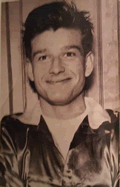 Photograph submitted by William Kay.
Photograph submitted by William Kay.
Berwick Rangers (1978-79 sponsor added, 1991-92 revised), Stranraer (1991-92 added), Stockport County (1985-86 sponsorship corrected), Huddersfield Town (1979-80 crest added).
On the right is Stan Anderson, who made over 400 appearances for Sunderland between 1952 and 1963, wearing the special "satin" shirt worn in floodlit friendlies in 1955-56. (Photograph courtesy of Stan Anderson: Captain of the North - M Metcalf 2010 submitted by Graham Brack).
Nik Yeomans has found a match programme that indicates that Chelsea first wore royal blue shirts against Lincoln City on 13 October 1906. Prior to this they played in Eton Blue.
23 April - FIFA Women's World Cup
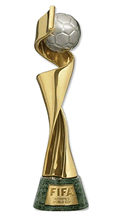 Four years ago I posted a kit record of the 2015 Women's World Cup in Canada and promised to create a full record but somehow I never got round to adding the previous tournaments. As the 2019 edition is nearly upon us I have been locked in one of the underground offices here at HFK Towers to put this right. Sustained by hourly espressos and generous portions of steak slice provided by our local butcher, Dai the Pie, I am pleased to announce that we now have on the site a complete record of the Women's World Cup from 1991 to 2019.
Four years ago I posted a kit record of the 2015 Women's World Cup in Canada and promised to create a full record but somehow I never got round to adding the previous tournaments. As the 2019 edition is nearly upon us I have been locked in one of the underground offices here at HFK Towers to put this right. Sustained by hourly espressos and generous portions of steak slice provided by our local butcher, Dai the Pie, I am pleased to announce that we now have on the site a complete record of the Women's World Cup from 1991 to 2019.
There are some gaps in the records for 1991 and 1995 and I hope the HFK elves will help me to fill these and alert me when the few missing kits for 2019 are released.
My thanks to everyone who has submitted updates over the last five weeks. I'll start working on these this week.
13 March - MLS 2019
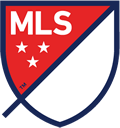 I've added the MLS 2019 section to the site today. This offers a good idea about the direction Adidas' designers are going in for the Women's World Cup (which I plan to cover) and the 2019-20 club season.
I've added the MLS 2019 section to the site today. This offers a good idea about the direction Adidas' designers are going in for the Women's World Cup (which I plan to cover) and the 2019-20 club season.
4 March - 2018-19 Update
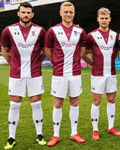 This summer, York City will be leaving Bootham Crescent, their home since 1922, to move into a brand new Community Stadium. To mark the occasion the club has commissioned a special, one-off strip that will be worn in their last home game of the season against AFC Telford on 27 April. Replicas went on sale on Saturday and were sold out in just three hours. More stock is on order.
This summer, York City will be leaving Bootham Crescent, their home since 1922, to move into a brand new Community Stadium. To mark the occasion the club has commissioned a special, one-off strip that will be worn in their last home game of the season against AFC Telford on 27 April. Replicas went on sale on Saturday and were sold out in just three hours. More stock is on order.
(Photograph courtesy of York City FC).
St Johnstone (socks changed), Doncaster Rovers (3rd shorts/socks confirmed).
23 February - International Updates
Wales 1884. In an interview (date unknown) Joe Wiliams (Oswestry Town) recalled being given a white shirt with a crest featuring a Welsh dragon surrounded by the words FA of Wales Cymru am Byth before the match against England. England are thought to have worn their usual white shirts so it is a mystery how anyone told the teams apart. This had occurred earlier in the decade and Wales resorted to draping a red scarf over their tops but in 1883 they had adopted cardinal and red halves to, presumably, avoid clashes. Quite why they went back to white shirts is perplexing.
Other Historical Material
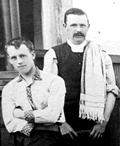 Tucked away in this photograph of Middlesbrough from 1884-85 submitted by Jonathon Auty are two nuggets of purest gold. While most of the team are wearing plain white shirts, two players have natty collars and cuffs with polka dots. This is the first photographic evidence we have for this unique outfit. We can also see that there is a crest which,
Tucked away in this photograph of Middlesbrough from 1884-85 submitted by Jonathon Auty are two nuggets of purest gold. While most of the team are wearing plain white shirts, two players have natty collars and cuffs with polka dots. This is the first photographic evidence we have for this unique outfit. We can also see that there is a crest which, 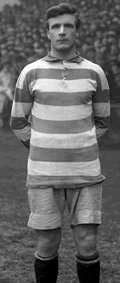 according to a newspaper report from 1886 is the town coat of arms.
according to a newspaper report from 1886 is the town coat of arms.
After the First World War Bury spent three seasons in red and white hoops before returning to more familiar plain white tops and navy knickers. This is the first photographic evidence I've seen of this rare outfit and was submitted by Simon Monks. Remarkably, although it was taken at the start of the 1920-21 season the committee have not seen fit to provide the players with new kit so they are here lining up in navy knicks that are completely washed out. Poor lambs.
Jonathon has also provided photographic evidence that confirms Middlesbrough Ironopolis wore dark knickers with their maroon and green tops.
Portsmouth (1993-95 shorts trim added): Cardiff City (1945-46 added): Clapton Orient (1930-31 shirt detailing corrected), Crewe Alexandra (1948-49 added, 1955-56 collar & cuffs corrected), Coventry City (1925-27, 1930-31 added, 1932-33, 1934-36 modified, Walsall (1900-01 added, 1888-89 knickers confirmed).
21 February
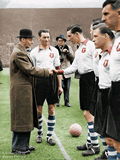 Long-time contributer George Chilvers (@Garswoodlatic) has come across a couple of cuttings in the Liverpool Echo from April 1950 concerning the Kit Liverpool wore in the FA Cup final against Arsenal. As we know the competition rules of the time required both teams to change when colours clashed. Liverpool planned to wear their regular white and black change strip which included their normal red and white hooped socks but the FA insisted that these had to be changed too. Liverpool had planned to wear their cup final strip at Portsmouth a week before the final so when they arrived in the morning, an official was despatched to a sports outfitters to buy a set of blue and white socks. Imagine the uproar today if the team turned out in anything blue! As usual, George has weaved his magic to colourise a
Long-time contributer George Chilvers (@Garswoodlatic) has come across a couple of cuttings in the Liverpool Echo from April 1950 concerning the Kit Liverpool wore in the FA Cup final against Arsenal. As we know the competition rules of the time required both teams to change when colours clashed. Liverpool planned to wear their regular white and black change strip which included their normal red and white hooped socks but the FA insisted that these had to be changed too. Liverpool had planned to wear their cup final strip at Portsmouth a week before the final so when they arrived in the morning, an official was despatched to a sports outfitters to buy a set of blue and white socks. Imagine the uproar today if the team turned out in anything blue! As usual, George has weaved his magic to colourise a 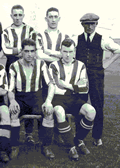 contemporary photograph so we can see what the kit looked like in action.
contemporary photograph so we can see what the kit looked like in action.
On the right is a photograph of Southport taken between the wars and contributed by Stephen Paramore. Stephen's grandfather, Jack Brunt is second from the right in the front row. Although the image is not dated, Brunt only played twice for the 'Port in October and December 1928 so we can identify the season.
Connah's Quay Nomads have been wearing sponsored shirts since the beginning of November.
The one-off strip worn by Wimbledon in their epic FA Cup matches against Leeds United in 1975 has been reinstated.
4 February
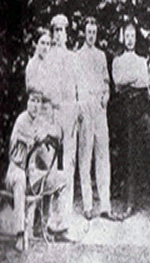 In December I received a large file from Robin Horton which he had compiled from Charles Alcock's Football Annuals from 1873 to 1881 containing the colours of almost 400 clubs. I've combined this information with material from Mike Bradbury's books, Lost Teams of the Midlands and Lost Teams of the North, photographs on the Welsh Football Data Archive and Brian McColl's enormous Scottish Football Historical Archive to create a new, greatly expanded Eminent Victorians section.
In December I received a large file from Robin Horton which he had compiled from Charles Alcock's Football Annuals from 1873 to 1881 containing the colours of almost 400 clubs. I've combined this information with material from Mike Bradbury's books, Lost Teams of the Midlands and Lost Teams of the North, photographs on the Welsh Football Data Archive and Brian McColl's enormous Scottish Football Historical Archive to create a new, greatly expanded Eminent Victorians section.
The Football Annuals provided details of early colours for a number of clubs that later joined the Football League and these have been added to the club sections. Accrington (1878-80), Ardwick (1887), Bolton Wanderers (1879-1882), Bootle (1888), Burton Swifts (1880), Chester Rovers (1881), Chesterfield (1881), Doncaster Rovers (1881), Middlesbrough (1879), Newcastle East End (1887), Stoke (1873), Wrexham (1879).
16 January - 2018-19 Updates
Our old chum, David King, has submitted a lot of material that allows me to add some detailing to the EPL/EFL kits for the current season. Walsall (1st, 2nd panels), AFC Wimbledon (3rd socks), Everton (1st socks), Colchester United (3rd shorts), Crewe Alexandra (2nd cuffs), Charlton Athletic (1st side panels), Fleetwood Town (2nd cuffs/shorts), Port Vale (1st, 2nd socks), Stevenage (2nd shorts), Yeovil Town (2nd cuffs), Carlisle United (1st socks), Notts County (1st, 2nd socks), Luton Town (charity strip), Liverpool (1st, 2nd, 3rd side trim), Cardiff City (3rd corrected), Huddersfield Town (3rd socks), Aston Villa (1st, 2nd, 3rd shorts), Hull City (3rd shorts),
15 January
When Newcastle travelled to West Bromwich Albion in January 1938 for an FA Cup Third Round tie, both sides had to change in accordance with the rules of the time. As the Geordie's change kit was identical to that of the home team, they borrowed a set of blue shirts and white knickers for the occasion.
Queen's Park Rangers (1937-38, March 1949 added), Notts County (March 1934. 1952-53, 1954-55, 1956-57 amended), Nelson (1924-27 added), West Bromwich Albion (1884-85 & 1886 FA Cup final kits corrected).
2018-19 Update: Crewe Alexandra (3rd), Sheffield Wednesday (3rd), Tranmere Rovers (2nd, 4th kits updated).
8 January
 We have become used to teams turning out in all sorts of variants to their registered kit to avoid clashes of shorts and, in particular socks, to make life easier for match officials. This season the trend has gone too far with teams turning out in change and third kits even when there is no clash, as Portsmouth did when visting Norwich City. This is a cynical attempt to promote sales of replica shirts which everyone at HFK Towers thinks is deplorable.
We have become used to teams turning out in all sorts of variants to their registered kit to avoid clashes of shorts and, in particular socks, to make life easier for match officials. This season the trend has gone too far with teams turning out in change and third kits even when there is no clash, as Portsmouth did when visting Norwich City. This is a cynical attempt to promote sales of replica shirts which everyone at HFK Towers thinks is deplorable.
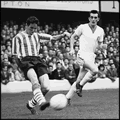 Visiting teams first began to change shorts and/or socks when these clashed in the 1970s. Prior to that the only concern was that the shirts had to be different, which makes this picture of Southampton playing Liverpool in
Visiting teams first began to change shorts and/or socks when these clashed in the 1970s. Prior to that the only concern was that the shirts had to be different, which makes this picture of Southampton playing Liverpool in 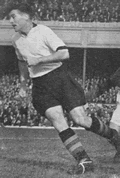 August 1960 rather unusual as the visitors are wearing their "home" shorts with their white alternative shirts and socks.
August 1960 rather unusual as the visitors are wearing their "home" shorts with their white alternative shirts and socks.
On the left is a previously unrecorded Aston Villa change kit from 1956-57 posted on Twitter by @MemorabiliaMal.
Millwall's 1975 crest added, Newport County (1956-57 socks updated), Norwich City socks amended 1965-1969, Bournemouth & Boscombe Athletic (1969-70 updated).
6 January - Happy New Year!
The HFK Elves have been busy over the festive period and I think we have now pinned down the date that Chelsea switched from maroon to red change shirts to 1933-34.

